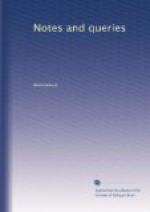JARLTZBERG.
Armenian Language.—This copious and widely-circulated language is known to but few in this country. If this meets the eye of one who is acquainted with it, will he kindly direct me whither I may find notices of it and its literature? Father Aucher’s Grammar, Armenian and English (Venice, 1819), is rather meagre in its details. I have heard it stated, I know not on what authority, that Lord Byron composed the English part of this grammar. This grammar contains the two Apocryphal Epistles found in the Armenian Bible, of the Corinthians to St. Paul, and St. Paul to the Corinthians. Like the Greek and German, “the different modes of producing compound epithets and words are the treasure and ornament of the Armenian language; a thousand varieties of compounded words may be made in this tongue,” p. 10. I believe we have no other grammar of this language in English.
JARLTZBERG
* * * * *
REPLIES
A TREATISE ON EQUIVOCATION.
My attention has recently been drawn to the inquiry of J.M. (Vol. i., p. 260.) respecting the work bearing this name. He inquires, “Was the book ever extant in MS. or print? What is its size, date, and extent?” These questions may in part be answered by the following extracts from Parsons’s Treatise tending to Mitigation, 1607, to {137} which J.M. refers as containing, “perhaps, all the substance of the Roman equivocation,” &c. It appears from these extracts that the treatise was circulated in MS.; that it consisted of ten chapters, and was on eight or nine sheets of paper. If Parsons’ statements are true, he, who was then at Douay, or elsewhere out of England, had not seen it till three years after it was referred to publicly by Sir E. Coke, in 1604. Should the description aid in discovering the tract in any library, it may in answering J.M.’s second Query, “Is it now extant, and where?”
(Cap. i. Sec. iii. p. 440.):—
“To hasten then to the matter, I am first to admonish the reader, that whereas this minister doth take upon him to confute a certain Catholicke manuscript Treatise, made in defence of Equivocation, and intercepted (as it seemeth) by them, I could never yet come to the sight therof, and therfore must admit,” &c.
And (p 44):—
“This Catholicke Treatise,
which I have hope to see ere it be
long, and if it come in time,
I may chance by some appendix, to
give you more notice of the
particulars.”
In the conclusion (cap. xiii. Sec.ix. p. 553.):—
“And now at this very instant having written hitherto, cometh to my handes the Catholicke Treatise itselfe of Equivocation before meneyoned,” &c.... “Albeit the whole Treatise itselfe be not large, nor conteyneth above 8 or 9 sheetes of written paper.”
And (Sec. xi. p. 554.):—




